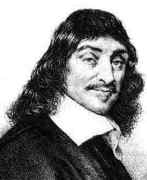Person: Descartes, René

René Descartes was a French philosopher whose work, La géométrie, includes his application of algebra to geometry from which we now have Cartesian geometry. His work had a great influence on both mathematicians and philosophers.
Mathematical Profile (Excerpt):
- René Descartes' parents were Joachim Descartes (1563-1640) and Jeanne Brochard (1566-1597).
- René was baptised in the Roman Catholic Church of Saint George in La Haye when he was four days old.
- Descartes was educated at the Jesuit college of La Flèche in Anjou.
- School had made Descartes understand how little he knew, the only subject which was satisfactory in his eyes was mathematics.
- Comparatively little is known of Descartes' life between 1614 and 1618.
- While serving Maximilian of Bavaria, Descartes was present as an official observer with the Catholic League at the Battle of the White Mountain near Prague in November 1620.
- From 1620 to 1628 Descartes travelled through Europe, spending time in Bohemia (1620), Hungary (1621), Germany, Holland and France (1622-23).
- By 1628 Descartes, tired of the bustle of Paris, the house full of people, and of the life of travelling he had before, decided to settle down where he could work in solitude.
- Soon after he settled in Holland, Descartes began work on his first major treatise on physics, Le Monde, ou Traité de la Lumière Ⓣ(The world or a treatise on light).
- In Holland, Descartes had a number of scientific friends as well as continued contact with Mersenne.
- Descartes was pressed by his friends to publish his ideas and, although he was adamant in not publishing Le Monde Ⓣ(The world or a treatise on light), he wrote a treatise on science under the title Discours de la méthode pour bien conduire sa raison et chercher la vérité dans les sciences Ⓣ(Discourse on the method for conducting one's reason well and seeking the truth in the sciences).
- The work describes what Descartes considers is a more satisfactory means of acquiring knowledge than that presented by Aristotle's logic.
- Only mathematics, Descartes feels, is certain, so all must be based on mathematics.
- La Dioptrique Ⓣ(Dioptics) is a work on optics and, although Descartes does not cite previous scientists for the ideas he puts forward, in fact there is little new.
- However many of Descartes' claims are not only wrong but could have easily been seen to be wrong if he had done some easy experiments.
- the Praxis was read by Descartes, and every line of Descartes' analysis bears token of the impression.
- Harriot's work on equations, however, may indeed have influenced Descartes who always claimed, clearly falsely, that nothing in his work was influenced by the work of others.
- Descartes' Meditations on First Philosophy, was published in 1641, designed for the philosopher and for the theologian.
- However many scientists were opposed to Descartes' ideas including Arnauld, Hobbes and Gassendi.
- The most comprehensive of Descartes' works, Principia Philosophiae Ⓣ(Principals of philosophy) was published in Amsterdam in 1644.
- Descartes did not believe in action at a distance.
- In many ways Descartes' theory, where forces work through contact, is more satisfactory than the mysterious effect of gravity acting at a distance.
- However Descartes' mechanics leaves much to be desired.
- Pleasing as Descartes' theory was, even the supporters of his natural philosophy such as the Cambridge metaphysical theologian Henry More, found objections.
- Descartes however in his replies makes no concessions to More's points.
- In 1644, the year his Meditations were published, Descartes visited France.
- In 1649 Queen Christina of Sweden persuaded Descartes to go to Stockholm.
- However the Queen wanted to draw tangents at 5 a.m. and Descartes broke the habit of his lifetime of getting up at 11 o'clock.
- We should end this biography by saying a little more about Descartes as a person.
Born 31 March 1596, La Haye (now Descartes),Touraine, France. Died 11 February 1650, Stockholm, Sweden.
View full biography at MacTutor
Tags relevant for this person:
Algebra, Analysis, Applied Maths, Astronomy, Geometry, Number Theory, Physics, Set Theory, Special Numbers And Numerals, Topology
Mentioned in:
Chapters: 1
Definitions: 2
Epochs: 3
Examples: 4
Parts: 5 6
Thank you to the contributors under CC BY-SA 4.0! 

- Github:
-

- non-Github:
- @J-J-O'Connor
- @E-F-Robertson
References
Adapted from other CC BY-SA 4.0 Sources:
- O’Connor, John J; Robertson, Edmund F: MacTutor History of Mathematics Archive
